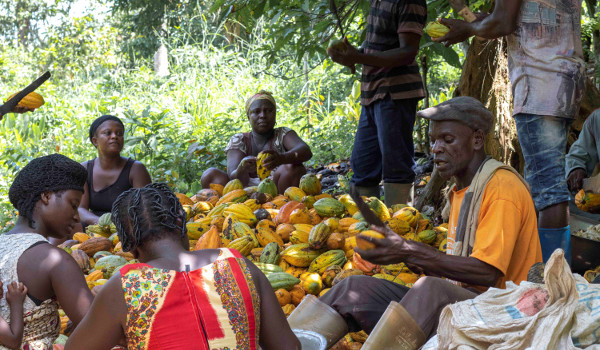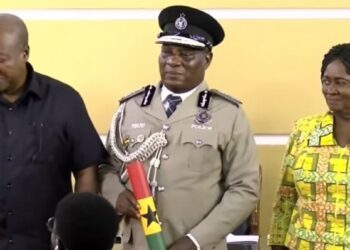The president of the National Cocoa Farmers Association of Ghana Mr Anane Boateng has stated that Ghana cocoabod is aware of their situation but nothing has been done to salvage the problem, reacting to what CocoBod CEO Mr Joseph Boahen Aidoo’s statement about 19000 hectares have been destroyed by illegal mining activities (galamsey) on Plan B Fm’s morning show “NKOSUO NSEM” with Ohene Addo, Mr Anane stressed that the board has failed in its obligations of protecting cocoa farmers and their activities, he alleged that most of the cocoa farmers whose trees were destroyed for rehabilitation or replanting have not received their compensation and illegal miners have also taken over cocoa production communities with their activities destroying thousands of acres of cocoa farms deepening the predicament coach farmers.
He again explained that the association has over 500 members and yet non of them have been put on the cocoa pension scheme since was announced, “Cocoa Farmers don’t have eligible agency to channel their grievances for proper redress” he noted.
The Ghana Cocoa Board (COCOBOD) has expressed grave concern over the alarming rate at which cocoa farms are being destroyed by illegal mining, also called galamsey, across the country.
The Chief Executive Officer of COCOBOD, Mr Joseph Boahen Aidoo, said in a presentation available to the media shows that more than 19,000 hectares (Ha) of cocoa farms had either been destroyed or affected by galamsey activities, leading to loss of income to farmers and investments by the board and the country at large.
In the presentation, made to the members of the boards of directors of COCOBOD and the Minerals Commission at a joint board meeting to find lasting solutions to the canker, Mr Aidoo said the destruction of cocoa farms through galamsey was pronounced in the Eastern, Western and Ashanti regions, from where more than 90 per cent of the country’s total cocoa production comes.
The meeting, which was convened by COCOBOD, the cocoa sector regulator, was co-chaired by the Board Chairman of COCOBOD, Peter Mac Manu, and the Board Chairperson of the Minerals Commission, Barbara Oteng-Gyasi.
Breakdown
The COCOBOD CEO disclosed that in the Eastern and the Western regions, more than 81 and 74 per cent, respectively, of cocoa farmlands had been affected by illegal digging and unregulated use of mercury and other chemicals to extract gold and other precious minerals.
In the Ashanti Region, he said, more than 68 per cent of cocoa farm areas were affected by the canker.
He said another 79.41Ha or two per cent of farms that were recently rehabilitated by the board had either been affected by the menace or were at risk of being affected.
Beyond destroying cocoa trees and farmlands, he said, illegal mining had led to the early dropping of pods, wilting, yellowing of leaves and the generally low yield on cocoa farms.
Those outcomes, he said, threatened the sustainability of the cocoa sector, which generated an average of $2.5 billion in foreign exchange every year, as well as its associated multi-billion cedi cocoa processing sub-sector and more than 800,000 jobs.
Maiden meeting
Mr Manu told the media that the meeting allowed the two sides to share candid opinions on the canker and how to resolve it.
Mr Manu, who is also a former National Chairman of the ruling New Patriotic Party, said the development had reached alarming levels, with almost all cocoa production regions affected, posing a serious threat to the sustainability of the cocoa sector.
“In major cocoa-growing communities, many of the forests have been devastated by illegal mining and we at COCOBOD think that the cocoa sector has had some major setbacks from these galamsey activities,” he noted.
That, he said, informed the decision by the board of COCOBOD to call a joint meeting with its counterparts at the Minerals Commission to deliberate on how to tackle the situation and save the cocoa sector from collapse.
Measures
On the conclusions reached after the meeting, Mr Manu, who is also a former Board Chairman of the Ghana Ports and Harbours Authority (GPHA), said COCOBOD and the Minerals Commission agreed to share information on the location of cocoa farms across the country to enable the commission to stop licensing such areas for mining.
He said they also agreed to strengthen their collaboration with the security services to ensure that illegal miners who destroyed cocoa farms were arrested and prosecuted, in line with relevant laws
He appealed to farmers to resist the temptation to give their farmlands for mining, noting that unlike mineral wealth, which was finite, cocoa farming was a life-long activity that could be passed on to generations.
Haphazard digging
For her part, Mrs Oteng-Gyasi decried galamsey activities on cocoa farms, noting that they risked limiting the gains from the “golden pod”.
She said her outfit was awaiting data on cocoa farm locations to superimpose them on its data to guide future licensing and allocation of concessions for mining.
The former Deputy Minister of Lands and Natural Resources expressed optimism that the data would reach the commission this week for subsequent actions to be taken.
She said it was in response to the effects of galamsey that the commission rolled out the Community Mining Scheme (CMS), aimed at turning illegal miners into responsible miners.
Mrs Oteng-Gyasi said the commission had also noticed that, unlike formal mining firms that undertook to prospect to determine the exact location of the mineral ore for focused digging and blasting, illegal miners lacked that capacity and expertise.
Consequently, she said, they engaged in “haphazard digging in search of the ore”, resulting in the wanton destruction of large tracts of land.
To address that, she said, the commission had partnered with the Geological Survey Authority to map out areas with ore bodies for subsequent allocation to miners under the CMS.
“But if we find that the area has ore but it is in a cocoa farming area, we will not allocate it. We will block those areas from being allocated,” she said.
Source:
Maxwell Ohene Addo/Planbfmonline










Discussion about this post